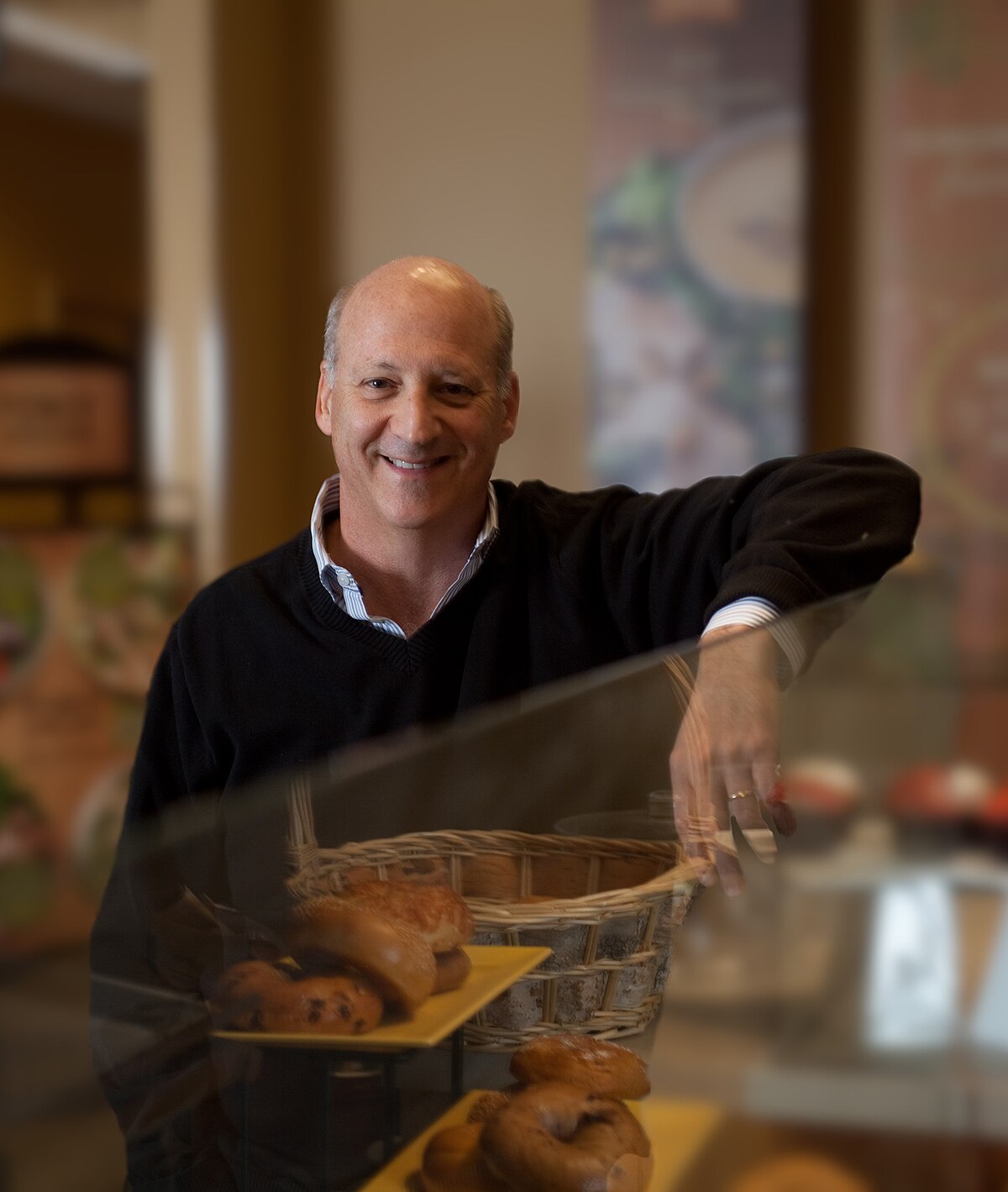Summary
This article explores the role of successful Panera Bread innovation. It draws on lessons learned from an interview with Panera Bread founder and former CEO Ron Shaich, who transformed a small bakery into a successful restaurant chain.
First of all, Ron Shaich encourages you to define your medium-term vision and draw up a plan to achieve it. He stresses that the vision must be constantly evaluated and adjusted to reflect changes in the market.
In a second step Shaich stresses that the world is constantly changing, and that companies must be able to adapt quickly to change. He warns against focusing solely on execution and neglecting innovation.
The article also illustrates the importance of differentiation for competitive advantage. Shaich emphasizes that companies need to offer something unique and special to stand out from their competitors.
The article also describes the four stages in Panera Bread's transformation, from cookie store to bakery-cafe, through specialization and resale to JAB Holding Co. for $7.5 billion.
Finally, Ron Shaich shares several leadership lessons, including the importance of innovation, differentiation, and staying open to opportunities. He also stresses the importance of creating your own identity and focusing on a specific audience.
Introduction
This publication was inspired by an interview with Emily Adeyanju, McKinsey Global Publishing's journalist, by Ron Shaich, founder and former CEO of Panera Bread, following the release of his book: "Know What Matters: Lessons from a Lifetime of Transformations (Harvard Business Review Press, October 2023).
Let's discover the principles of modern leadership and business innovation. Inspired by an interview with Ron Shaich, founder of Panera Bread, discover the keys to his success with Panera Bread Innovation. Through his book, Shaich shares valuable lessons on strategic vision, trend anticipation and market differentiation. Explore the stages of Panera Bread's transformation and the leadership lessons learned from this experience. From the importance of defining a medium-term vision to the need to innovate to remain competitive, dive into a captivating journey to the heart of corporate leadership and innovation.
The 3 fundamentals of a winning strategy: Vision, anticipation and differentiation in the success of Panera Bread
"That's the thesis of this book. Start by knowing where you want to go, understanding your organization - and ultimately your life - as you go.
Then figure out the path to get there.""
Panera Bread's success: The essential role of vision

Drawing on his own experience as a parent, the author stresses that the time to take stock of one's life is not in the ninth and final inning. It has to be done in the seventh, fifth or third innings. "Based on the experience with my parents, every Christmas week I started to spend a few days saying to myself: 'Okay, Ron, where do you want to be in three years, in five years, in seven years.this with regard to your health, your work, your relationships, your own personal relationship with your God,with spirituality? Where do you want to be? This comes down to defining your medium-term vision.
Once you've defined where you'd like to ask the question, "How am I going to get there?" This process started to work for me says the author. I thought, "If this works for me, this is exactly how we want to run our businesses". Essentially, the process of defining today what will be important tomorrow, consists of determining "Where do I want to land in the future? Do I know where I want to be in three years, five years, seven years? How can I develop an effective plan to get there? To answer this question, we'll look at the importance of being open to anticipation.
The importance of anticipation in a fast-changing world Panera Bread success story

Panera Bread's success: Why is now the riskiest time?
"The big challenges for consistent entrepreneurs to get their business off the ground and move their projects forward. This can be due to a variety of factors such as competition, limited funding, or operational obstacles."
Change is absolute. It is permanent. By its very nature, an organization locks itself into processes designed to reproduce or extend what it does. If we become very good at doing what was appreciated yesterday, while the world continues to evolve, we are not very aware of this change. We are no longer sufficiently aware of the ongoing demand to adapt to these changes. This is how we end up collapsing. Hence the importance of distinguishing between efficiency and performance
The difference between efficiency and performance
It has to be said that in the restaurant sector, there are only a few companies worth more than a billion dollars. These companies are often very effective at what they do, but not very efficient. There's a difference between the creation phase and the impact on an organization.
Indeed, the research phase and the implementation phase have distinct roles, and can have a significant impact on a company's operations, hence the fundamental role of differentiation.

Differentiation for competitive advantage - Panera Bread Innovation success story
The ripening phase
As your capital grows, you realize that you've made an important discovery, but now you need to make it more effective. Next comes purchasing, then financial planning. Over time, you begin to discover these two different aspects of the organization: creation and execution. Efficiency, the invaluable source of creation, makes a real difference. Margins are improving,
the company starts to grow. This raises the question of whether efficiency and innovation go hand in hand.
The duality of efficiency and innovation
- The daydreaming stage
As they grow larger, many organizations gain in execution efficiency.
People often wake up 20 years later and realize that all they have is execution, not discovery. That's not a problem, except that the world keeps changing and they have to keep evolving too. The end result is that very often very large companies have very effective production strategies , but modest innovation capabilities, in a rapidly changing world. They are very good at delivering what yesterday's customer wants, but not necessarily what tomorrow's customer needs.
This can lead to a long-term loss of innovation. This is the fundamental conundrum of any large organization.
In the early stages of business creation, the emphasis is on exploring new ideas and creativity. It' s a phase of dreaming and conceptualization that logically gives way to the implementation phase.
- The implementation stage
The second stage involves concrete implementation and tangible proof. This means moving from the imaginary to the reality of Panera Bread's success.
Hence the importance of balancing these two aspects in company management?
What's the secret to maintaining a competitive edge? advantage?
Competitive advantage is everything. It means that your target customer won't settle for the alternatives available to them.
If you don't stand for something, if you don't differentiate yourself, if you're not special in some way, you'll only get your share of the market. In most sectors of today's economy, if you just get your share of the market, it won't be enough.
In the end, you won't have a sustainable, successful business. "I care about being a better competitive alternative. I want my customers to be treated better than others in certain fundamental ways. When I do that, I win," emphasizes Ron Shaich.
The most powerful responsibility of a business leader, or any other organization, is to transform itself once we have discovered what will matter in the future.
The keys to Panera Bread's success
"The key to success is, firstly, to tell each other the truth, to know where you really stand, to know the competitive market. Second, know what's important. Third, you have to do what's important."
"What I'm most proud of in my career isn't the stock performance, which was excellent. Nor is it the fact that we sold the company in the biggest deal ever made at the time in the U.S. foodservice sector. What makes me happy are the opportunities I've had to learn something, to understand what's important, and to transform my business to get there," says Ron. This has happened every six or seven years for 35 years. The author has experienced massivetransformations, which his competitors have perceived as massive gambles. However, he saw these changes as necessary if the company was to survive in the future.
Now that the role of differentiation has been clarified, it remains to describe the stages in Panera Bred's transformation.
The four stages of Panera Bread's transformation:
● From cookie store to bakery-cafe
● From bakery-cafe to fast casual
● Panera specialization
● Resale of Panera
It has to be said that the start-up phase of a company is certainly one of the most difficult for a manager. At this stage of the company's life, there are no economies of scale and no strong market presence. Customer knowledge is still limited. To limit these structural impediments, you need to do something that allows you to stand out in a powerful way. You discover a better alternative.
It is beginning to gain ground. With Panera Bread's success comes the need for additional capital.
● First step: From cookie store to bakery-cafe
Initially, Ron merged his cookie store with a chain of three French bakeries called Au Bon Pain.
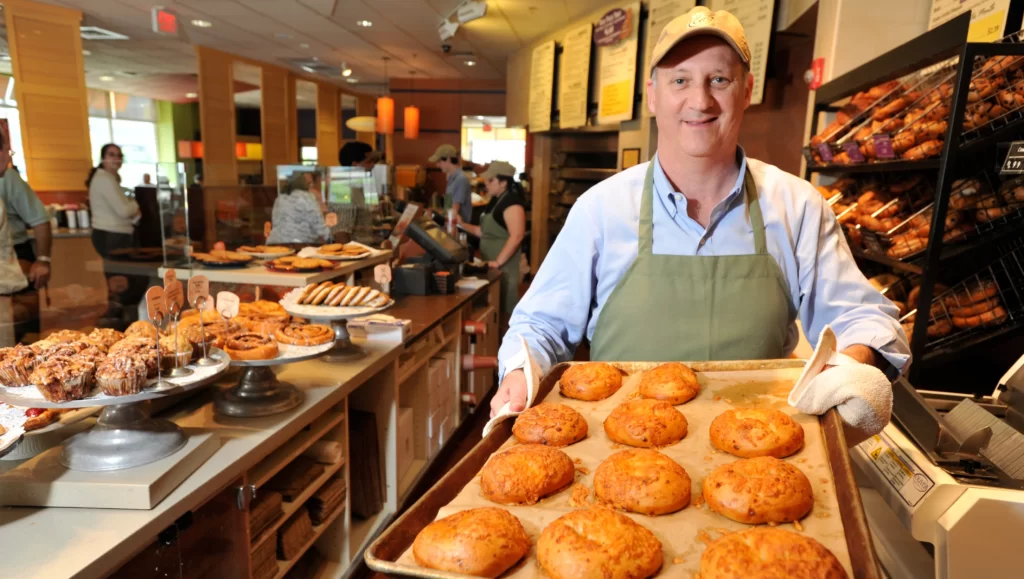
● Second stage: From bakery-café to fast-casual casual
He then transformed his bakery from a croissant and bread shop into a bakery-cafe, using croissants and bread as a platform for selling sandwiches. The first transformation took place after an apprenticeship.

that people wanted bread to eat a sandwich. People would come in and ask, "Could I have that baguette, can you cut it?"
They put roast beef and Boursin on this French bread and made themselves a sandwich! Clearly, it wasn't the bread that represented an opportunity, but the sale of what they wanted: the sandwich. This learning led to the company's transformation from a simple croissant and bread store to the first bakery-cafe in the USA. It was a resounding success, establishing itself in every shopping mall. A few years later, this ramshackle little company had 100 stores and Ron Shaich took it public. All this was the result of that first learning curve and that first transformation.
Find your niche by differentiating yourself to create more value to its customers. Discover today what will count tomorrow.
● Third stage: Panera specialization
- Ron Staich's diagnosis
In short, it happened six or seven years later, when Ron Shaich realized that the world was changing. In the early '90s, almost all the major consumer product categories were dominated by two or three players - oligopolies, as it were.
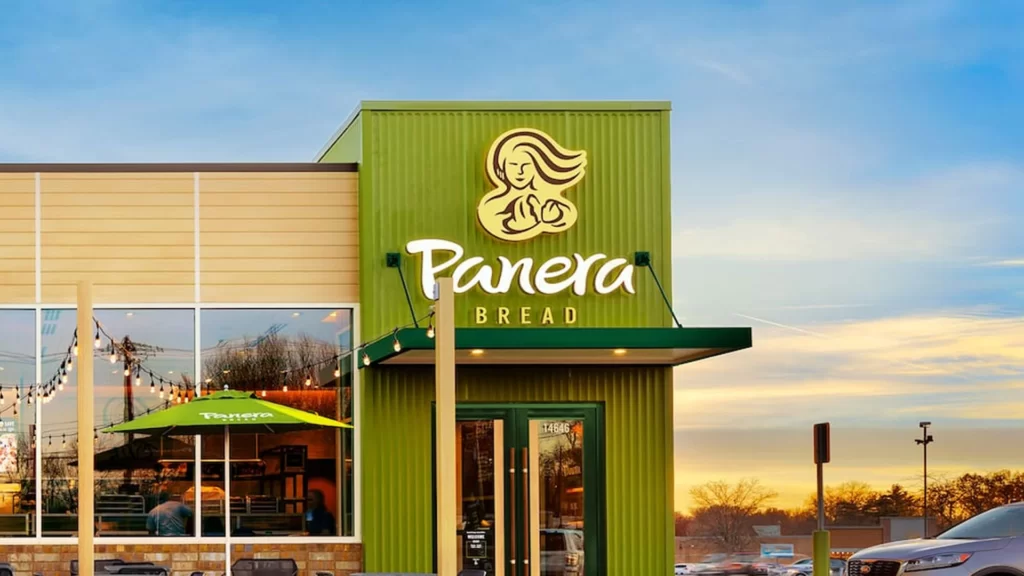
These are markets where a small number of sellers have a monopoly on supply, while buyers are numerous. Ron began to see a reaction from some consumers to this situation, a desire to feel special in a mass market that was no longer special. This is what happened in the coffee sector, with Folgers and Maxwell House giving way to specialty coffee shops. We saw it in soft drinks: Coke and Pepsi began to evolve as people wanted Snapple and other drinks. The author began to think: "This is the same trend we've seen in a lot of categories, this desire for specialization. How is this going to affect the food industry?"
- Implementing differentiation
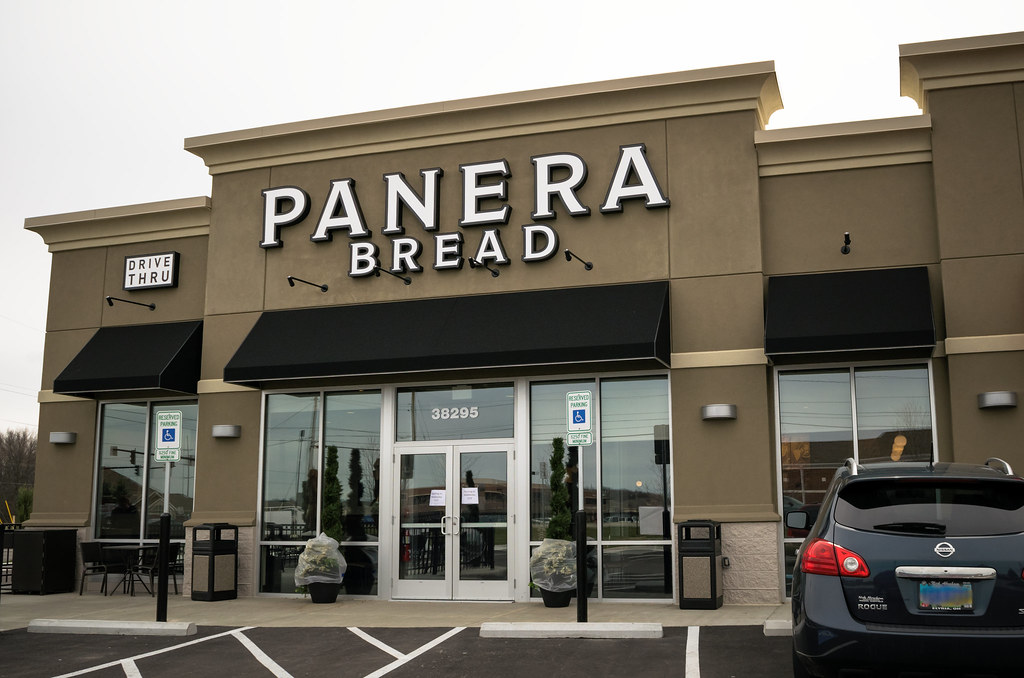
Then he said to himself, "What if we created a restaurant that was different from those that existed at the time - fast food and fine dining? What if we created a restaurant where the food honored people, where they felt respected, in an environment that engaged them and with attentive staff? If we could do that, we'd soon be changing the way the food industry works. "Perhaps we could offer people something that would uplift them, give them greater self-esteem and appeal to an important niche in the market."
The slogan that "All people want is fast food or fine dining" has become the genesis of an outdated time. It's what's known today as fast casual. It's an $80 billion market niche that Ron is very pleased to have helped discern and understand. "I'm proud to have discovered today what will matter tomorrow and to have put it in place." He says.
● Fourth step: Reselling Panera
- Panera's potential
Panera was one of four divisions of a public company, and the third largest. In the spirit of telling each other the truth, figuring out what's important and taking action, Ron realized that Panera had the potential to become a nationally dominant company. "Yet we were likely to mess things up and spread ourselves too thin because we had four companies," he says.
"This company was the jewel, and we had to change the paradigm. I realized I had to make sure it had all the financial and human resources it needed." Then he made a decision that people thought was insane
- The Panera resale turn
In 2014, Ron Shaich took the initiative to sell Panera Bread to JAB Holding Co. for $7.5 billion in 2017. He made this decision for several strategic reasons:
● Capitalizing on growth
Panera was a fast-growing company , but Ron Shaich realized that to continue to grow and prosper, he would need significant capital. The sale to JAB provided Panera with considerable resources to accelerate its growth.
● Access to capital
The sale gave Panera access to substantial funds to invest in new initiatives, such as the expansion of its restaurant network, technology, research and development, etc. Leadership lessons naturally flow from these impressive achievements.
Leadership lessons learned from the above.
● Providing your company with the means to grow, even if you no longer own it
● Innovation as a growth driver
● How maintaining a contrarian position has benefited Panera Bread
● The importance of creating your own identity
● Staying open to opportunities

● Lesson one: Provide the means for growth to your business, even if you no longer owner
Since most organizations are made up of functional managers, they are very good at saying "no" to defend their function. The problem is that very few say "yes". To say "yes" is to commit oneself essentially to the direction of the company itself, and not to that of the functions.
● Lesson two: Innovation as a growth driver growth
Invention is so powerful and so profoundly important to an organization that it requires the leadership and commitment of the CEO. If the CEO sees himself as a mere administrator, the company will fail. He can't prepare the company for the future. Ron Shaich began by continually striving to tell himself the truth about his company's position in the market and its customers' expectations. He asked himself: "What's really going to matter? What would it take to continue to stay current, to stay contemporary, to create better food environments that engage humanity?"
That said, the innovation strategy ultimately took the form of transformation. But none of this can happen if the CEO doesn't see himself as the chief innovator.
● Lesson three: How maintaining a position position has been beneficial Panera Bread
Everything about the book has to do with a contrarian worldview. Entrepreneurs are opportunists. They find opportunities. The biggest risk is not seizing them. That's what we call thinking against the grain.
It means going against what is contemporary and conventional. By its very nature, running a big business and building a better competitive alternative demands that you go against the grain. If you do what everyone else is doing, you'll get your share of the market, but you won't do anything better. Ron Shaich's objective was to find out how to create differentiation. Differentiation requires a contradictory point of view. "In fact, I'm a cynical optimist. I'm a firm believer in possibilities, but I'm very cynical about the many things that can happen along the way," says Ron.
● Lesson four: The importance of creating your own own identity
- The power of intention
- The right question to ask
"I always ask a question. If everyone's going left, is there a real opportunity on the right because there's a void? What is a void? How do you think about it and where do you go?" the author clarifies.
The common denominator of the book is not simply contrary thinking, but what lies at the root of this state of mind. It's about intention. If you don't know exactly why you're doing something, it won't matter. Most people look to their competitors to define what they do. They follow their competitors. We've never done that, Ron. Instead, we asked ourselves, "Why are our competitors doing this, and will it work? And what would work better?"
- Being unique
After all, if you try to please everyone all the time, you'll never please anyone. In reality, we live in a niche market. You don't have to be everything to everyone. But it's by understanding that you want to be at the heart of people's love and affection for you and make a difference to them, in a unique way, that you'll find success in most activities where there are many alternatives .
- Offer a unique and exceptional product
This statement means that in the business world, it's not compulsory to try to please everyone or to try to be the solution for all needs. Sometimes, it's more effective to focus on a specific audience and differentiate yourself by offering something unique and exceptional for them.
Ron Shaich points out that by focusing on satisfying and deeply engaging this specific audience, a company can be more successful than simply trying to be everything to everyone. This approach enables the company to stand out from its competitors and respond more effectively to the needs of its target audience, which can lead to greater success in the marketplace.
● Lesson five: Stay open to opportunities
Finally, one of the most common misconceptions is that entrepreneurs are risk-takers. This should not be the case. What a manager should be looking for is: opportunities.
" I see opportunities all around me. The riskiest action is to do everything in my power to seize that opportunity and make sure I can realize it", says Ron. Often, entrepreneurs see the context in terms of the bottom line, i.e. financial success. But if you want to succeed as an entrepreneur, you'd better enjoy what the business does much more than what it generates.
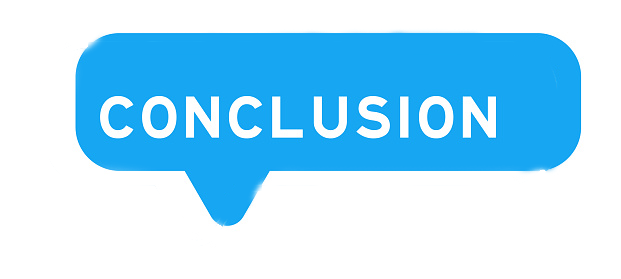
Ron Shaich's teachings, illustrated through the story of Panera Bread, highlight the crucial importance of vision, innovation and leadership in the business world. His ability to anticipate trends, differentiate his company and make bold decisions have been key factors in his success. Beyond creating a successful business, Shaich emphasizes the importance of creating sustainable value for all stakeholders and making a positive contribution to society. Whether in business or in life, Shaich's lessons resonate as guides to achieving success and making a significant impact.
For more content on the role of innovation, I recommend reading my article " Steeve Jobs Lessons "

